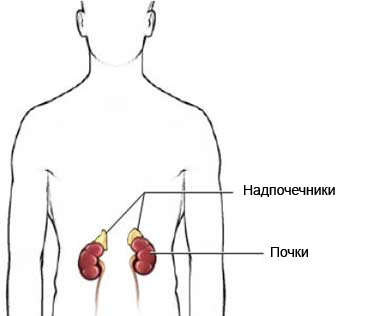Adrenalэktomiya – laparoscopic surgery – Laparoscopic surgery to remove the adrenal glands
Description of laparoscopic surgery to remove the adrenal glands
Adrenalэktomiya – removal of one or both adrenal glands. This gland is located on top of each kidney. The adrenal glands produce several hormones, including cortisol, aldosterone, and sex hormones.

Indications for laparoscopic surgery to remove the adrenal glands
The adrenal glands can be removed in the following cases:
- Cancer Adrenal;
- Diseases of the adrenal gland, production of too many hormones (eg, excess cortisol – Cushing's syndrome, excess aldosterone – Horse Syndrome, or an overabundance of adrenaline – pheochromocytoma);
- The large mass of the adrenal gland;
- The disorder of the adrenal glands, the cause of which can not be found.
Possible complications during surgery
If you plan to have surgery, you need to know about possible complications during adrenalectomy, which may include:
- Insufficient cortisol production;
- Lowering blood pressure;
- Bleeding;
- Infections of kidney, urinary tract, light;
- Blood clots in the legs;
- Injuries blizlezhaschh bodies;
- Adverse reaction to anesthesia.
Factors, that may increase the risk of complications include:
- Age: 60 and older;
- Obesity;
- Prolonged excess cortisol;
- Smoking;
- Poor diet;
- Recent or chronic illness;
- Problems with heart or lung;
- Alcoholism;
- The use of some drugs (Tablets of blood pressure, muscle relaxants, trankvilizatorы, hypnotics, insulin, steroids, sedatives, or sleeping pills)
- Drug use (eg, LSD, hallucinogens, marijuana, or cocaine).
How is the operation?
Preparing for Surgery
Before the operation it is necessary to pass the following tests:
- Medical checkup;
- Blood test;
- Analysis of urine;
- Abdominal ultrasound;
- COMPUTER tomography of the abdomen – X-ray examination, wherein the computer is used, to make pictures of the kidneys and / or adrenal glands;
- MRT – test, which uses magnetic waves, to make pictures of the kidneys and / or adrenal glands;
- COMPUTER imaging head – Exam pituitary (this gland controls the adrenal glands);
- Radiation scanning (Или sent NP-59) – test, wherein a small amount of radioactive material injected into the body, and snapshots is determined, If cancer;
- It is necessary to take certain medications, to find out, why the adrenal glands are not working properly.
Perhaps it will be necessary to stop taking certain medicines a week before surgery, eg:
- Aspirin or other anti-inflammatory drugs;
- Do not take blood thinners, such as warfarin, Clopidogrel.
You can not eat after midnight the day of surgery. You can also take a laxative or enema, to cleanse the bowel.
Immediately before the operation necessary to control blood pressure, and, if necessary, stabilize it to normal levels.
Anesthesia
The operation is performed under general anesthesia, during the operation the patient is asleep.
Activity description
Before the surgery needed intravenous antibiotics and hormones.
In laparoscopy, the doctor makes a 3-4 small incisions in the abdomen. The laparoscope is inserted into one of the holes, an image of the internal organs will be seen on the monitor. To better see the internal organs, the belly is filled with carbon dioxide. Miniature laparoscopic instruments are used to separate the adrenal gland from the kidney. After that, the adrenal glands are removed through an incision. The incisions are closed with stitches or staples, then superimposed sterile dressing.
The doctor may put a thin, a flexible tube into the area, where iron was removed. For this tube will remove any liquid, which appear after surgery. It is usually removed one week after surgery.
If there is a need, the doctor may switch to open surgery – laparotomy.
After operation
After surgery, the patient is sent to the recovery room until the end of anesthesia. The adrenal glands are sent to a lab for examination.
How long does the surgery?
The operation takes a half to four hours.
Will it hurt?
Anesthesia will prevent pain during surgery. For pain relief after surgery appoint appropriate painkillers.
The time spent in hospital
The patient is in the hospital 2 – 3 trustable.
Postoperative care
In the hospital
- Within a few hours after surgery, perhaps, It is the feeling of nausea. The doctor may place a nasogastric tube through the nose into the stomach, to remove stomach acid. In this case, the patient receives nutrients and medications intravenously. After, nausea will pass, is assigned to a bland diet.
- It is necessary to wear special compression stockings, to reduce the possibility of blood clots forming in the legs.
- The body will produce significantly less hormones . The doctor may prescribe taking hormones right after surgery, with a gradual reduction of the dose.
Houses
Recovery after surgery can take 7 – 10 days. For normal recovery subject to the following conditions:
- It is necessary to ensure that, that the body produces sufficient amounts of hormones, or to fill their lack of medicines;
- It is necessary to control weight ezhndnevno, and report their increase by more than a kilogram. This may indicate that the accumulation of fluid in the body;
- It is necessary to control blood pressure;
- It is necessary to gradually increase the motor activity;
- Check with the doctor, How soon after surgery can take water treatments;
- It is necessary to follow the doctor's instructions.
It is necessary to go to the hospital in cases
- Signs of infection, including fever and chills;
- Redness, edema, pain, bleeding from the incision;
- Nausea and / or vomiting which is not tested for more than two days after hospital discharge;
- Inability to relieve pain using painkillers;
- Pain, burning during urination, blood in urine;
- Cough, breathlessness, chest pain;
- Pain and / or swelling in the legs, ykrah;
- Headache;
- Vertigo;
- Any other unpleasant symptoms.
